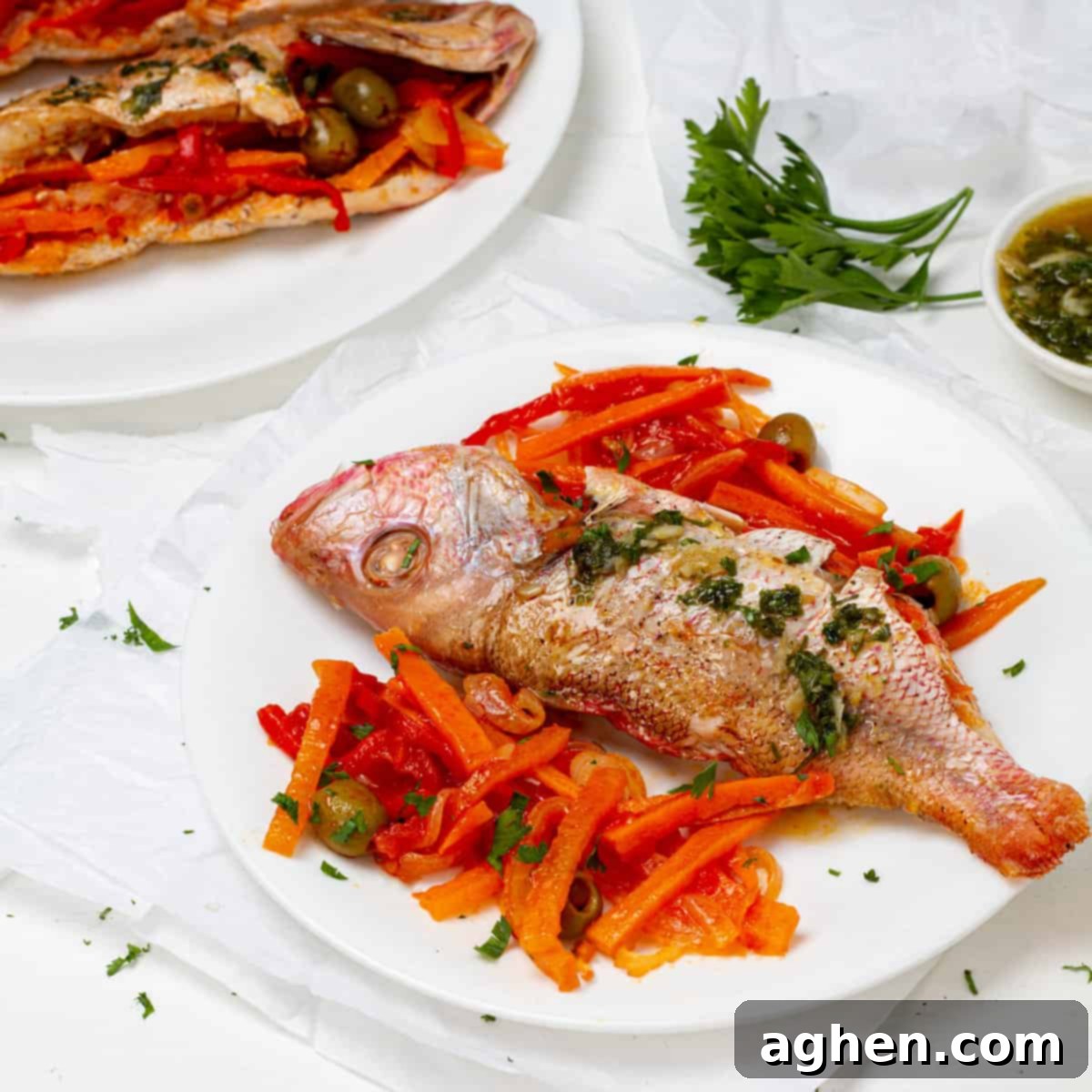Mastering Stuffed Fish: An Easy & Flavorful Recipe for Every Occasion
Stuffed fish is a culinary treasure, celebrated across diverse cultures for its exquisite taste and elegant presentation. From the sun-kissed coasts of the Mediterranean, where fresh herbs and olives infuse delicate white fish, to the vibrant culinary traditions of the Pacific, each region offers a unique take on this versatile dish. It’s a testament to global creativity, transforming a simple fish into a memorable meal brimming with flavors and textures. Whether prepared for a festive gathering or a cozy family dinner, stuffed fish consistently impresses with its delicious simplicity and sophisticated charm. This comprehensive guide will walk you through crafting a perfectly cooked, beautifully presented stuffed fish that is sure to become a cherished addition to your culinary repertoire.
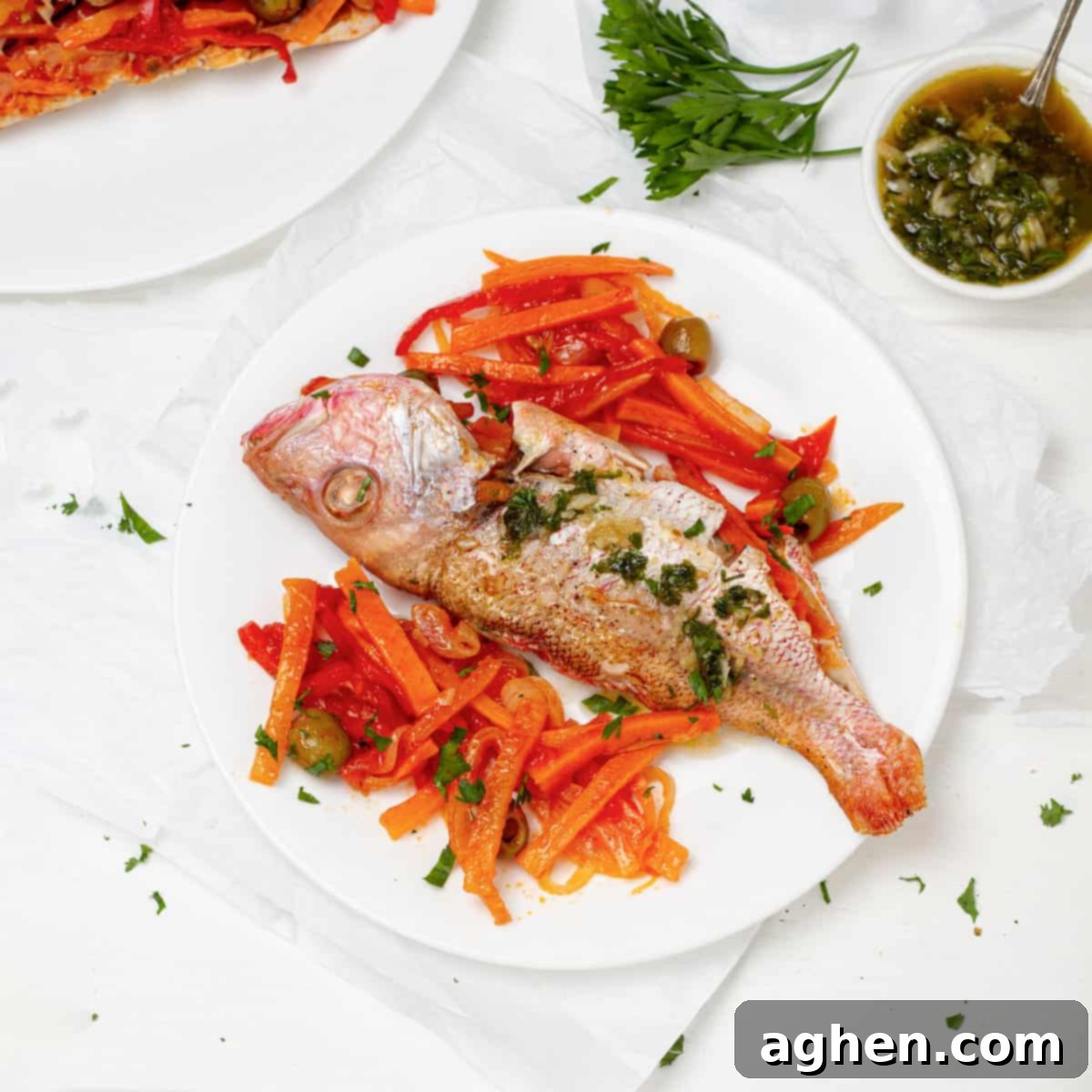
Why You Should Try This Stuffed Fish Recipe
Preparing stuffed fish offers a delightful experience for both the cook and the diners. Here are several compelling reasons to add this elegant dish to your meal rotation, highlighting its benefits for busy home cooks and discerning palates alike:
- Effortless Elegance: Stuffed fish naturally presents beautifully. The golden-brown skin, the vibrant filling peeking out, and the aromatic steam make it an impressive centerpiece on any table. It elevates any dining experience, making guests feel special and transforming a regular dinner into a celebratory occasion. Despite its sophisticated appearance, this recipe is surprisingly approachable to prepare, looking like it required hours of intricate work but in reality, being quite straightforward.
- Surprisingly Simple Preparation: Don’t let its gourmet facade fool you; this recipe is remarkably easy to follow. With less than 20 minutes of active prep time, you can assemble a dish that tastes and looks exceptional. The majority of the cooking time is hands-off baking, allowing you to focus on other aspects of your meal, prepare complementary side dishes, or simply relax before dinner. It’s an ideal choice for busy weeknights when you crave something special and healthy without the fuss.
- Unmatched Versatility & Customization: One of the greatest advantages of stuffed fish is its incredible adaptability. You have complete freedom to select your favorite type of fish and pair it with a medley of fresh, seasonal vegetables. This not only allows you to maximize flavor by using peak-season produce but also offers an economical approach, as you can choose ingredients that are readily available and affordable. The possibilities for fillings, seasonings, and even cooking methods are endless, ensuring you can tailor the dish to your dietary preferences, what’s fresh at the market, or simply what you’re craving.
- Healthy & Wholesome Meal: Fish is an excellent source of lean protein, beneficial omega-3 fatty acids, and essential vitamins and minerals that are crucial for overall health. When combined with a generous stuffing of colorful, nutrient-rich vegetables, this dish becomes a powerhouse of wholesome goodness. It’s a light yet incredibly satisfying meal that supports a healthy lifestyle without compromising on delicious flavor or culinary excitement.
- Rich, Infused Flavor Profile: The genius of stuffing a fish lies in how the filling’s aromatic flavors permeate the fish from the inside out as it bakes. The combination of seasoned fish, aromatic sautéed vegetables, and a simple yet flavorful butter sauce creates a harmonious and deeply satisfying blend of tastes and textures. The internal stuffing also helps to keep the fish incredibly moist and tender, ensuring every bite is succulent and flavorful, creating a truly memorable culinary experience.
Preparation Time: 20 minutes
Cooking Time: 30 minutes
Servings: 6
Essential Ingredients for Your Stuffed Fish
Crafting the perfect stuffed fish starts with fresh, quality ingredients. Here’s a detailed list of what you’ll need for this delicious and impressive recipe:
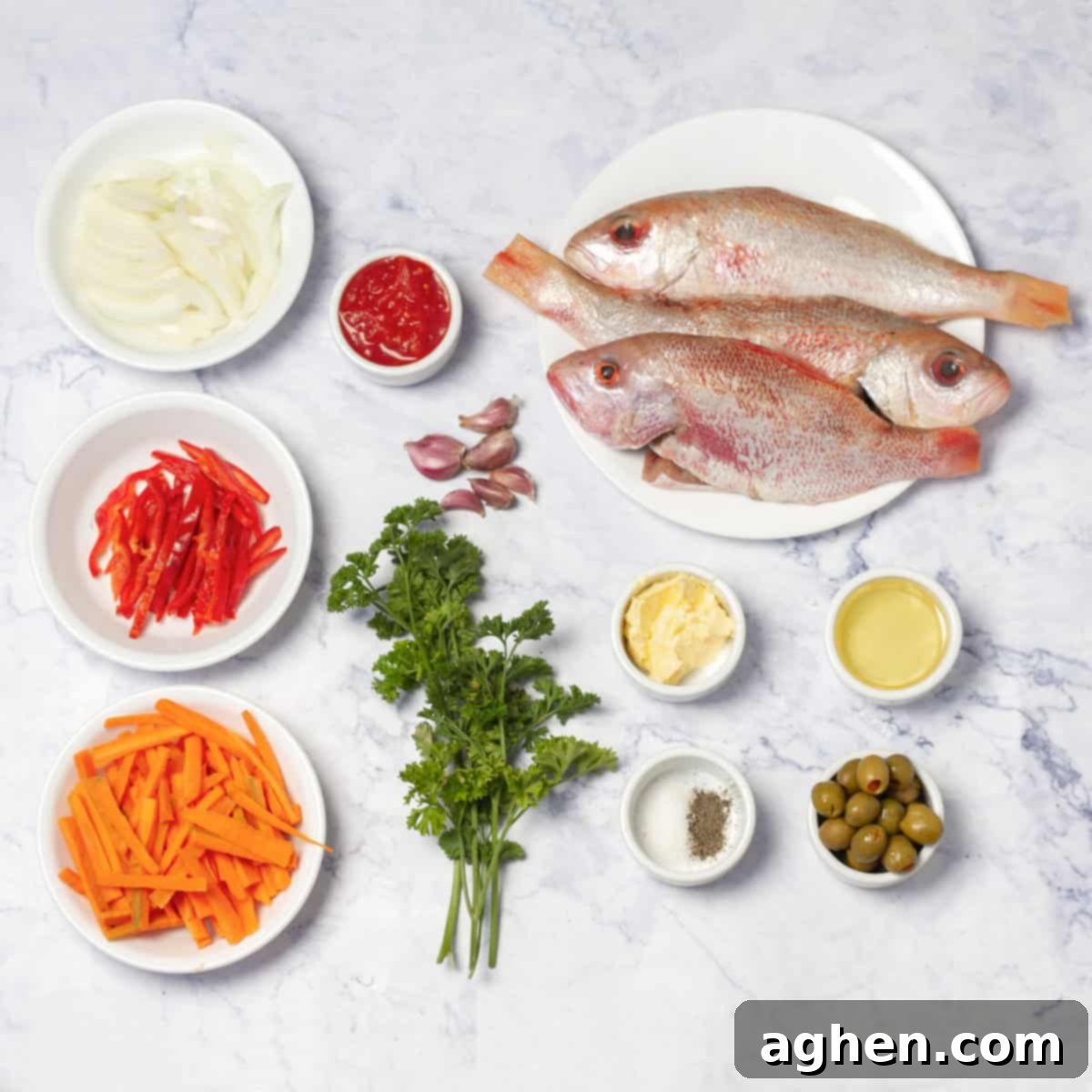
- 3 whole fish, approximately 500g (about 1.1 lbs) each. Excellent choices include Snapper, Sea Bass, or Trout due to their firm flesh and mild flavor.
- 1 garlic clove, minced (specifically for seasoning the fish cavity)
- Salt and freshly ground black pepper to taste (for both the fish and the filling)
For the Flavorful Vegetable Filling:
This vibrant medley of vegetables adds essential texture, moisture, and a burst of savory flavor to your fish. Feel free to adjust these based on your personal preference or what fresh produce is available and in season.
- 1 teaspoon olive oil (for sautéing the vegetables)
- 1 medium white onion, thinly sliced
- 1 large red bell pepper, thinly sliced
- 1 medium carrot, thinly sliced or julienned
- 1 large ripe tomato, grated (or finely diced)
- 12 olives, pitted and sliced (Kalamata or green olives work wonderfully for a briny touch)
For the Aromatic Butter Sauce:
A simple yet rich butter sauce to drizzle over the cooked fish, adding a luxurious finish, extra moisture, and an irresistible aroma.
- A handful of fresh parsley, finely chopped
- 1 tablespoon light butter (or regular unsalted butter for a richer flavor)
- 6 cloves garlic, minced (a generous amount to infuse the sauce with deep, aromatic flavor)
- 2 tablespoons water (or white wine for an extra layer of sophisticated taste)
Step-by-Step Instructions: How to Prepare Delicious Stuffed Fish
Follow these detailed instructions carefully to create a show-stopping stuffed fish that’s cooked to perfection, ensuring a moist interior and flavorful crust:
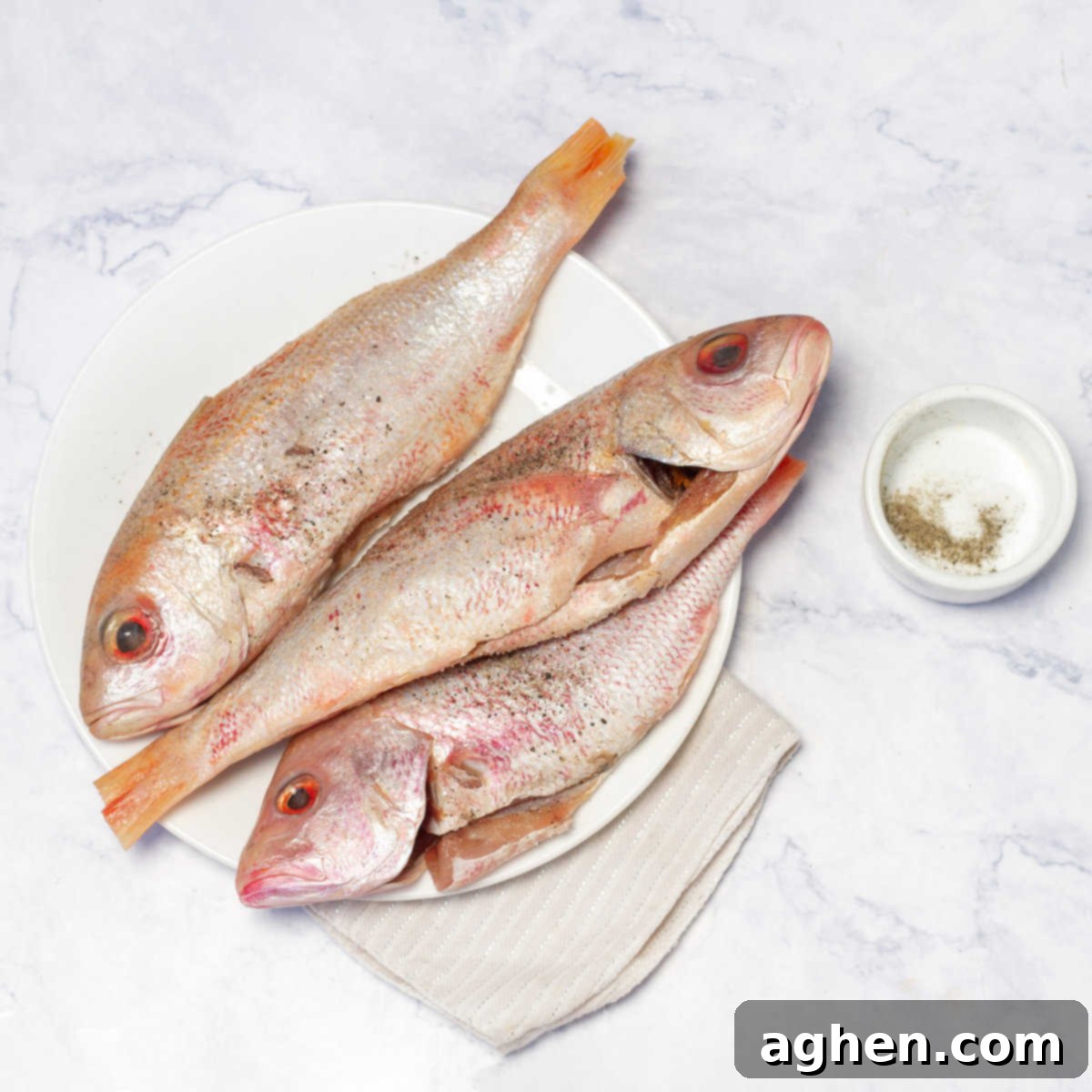
- Prepare the Fish: Begin by preheating your oven to 375°F (190°C). Thoroughly clean each fish, ensuring all scales and innards are completely removed. Rinse them meticulously under cold running water, then pat them completely dry with paper towels – this step is absolutely crucial for achieving crisp skin and preventing any “fishy” odors. Using a sharp knife, make a single lengthwise slit along the belly of each fish, extending from just behind the gills to the tail, taking care not to cut all the way through to the other side. This careful incision creates a perfect pocket for your filling. Generously season the inside cavity of each fish with the minced garlic, salt, and black pepper. Do not be shy with the seasoning here; this is where much of the internal flavor will develop.
- Prepare the Filling: Heat 1 teaspoon of olive oil in a large skillet over medium heat. Add the thinly sliced white onion, red bell pepper, and carrot. Sauté for about 5 minutes, stirring occasionally, until the vegetables begin to soften and become slightly translucent. It’s important not to brown them too much, as they will continue to cook in the oven. Stir in the grated tomato and sliced olives. Continue to cook for an additional 3-4 minutes, allowing the flavors to meld together and the tomato to break down slightly, creating a richer base. Remove the skillet from the heat and set aside to cool slightly before handling.
- Stuff the Fish: Once the vegetable filling has cooled enough to handle comfortably, carefully spoon it into the prepared cavity of each seasoned fish. Ensure the mixture is evenly distributed throughout the belly, but be mindful not to overstuff, as this can cause the fish to tear or burst during the baking process. To keep the filling securely inside and prevent it from spilling out, use sturdy wooden toothpicks or kitchen twine to sew or tie the belly opening shut. This simple step is essential for a tidy presentation and to retain all the delicious flavors.
- Bake the Stuffed Fish: Lightly grease a baking dish with olive oil to prevent sticking. Carefully place the stuffed fish in the prepared dish. To ensure the fish remains incredibly moist and tender during cooking, cover the baking dish tightly with aluminum foil. Bake in the preheated oven for 25-30 minutes. To check for perfect doneness, insert a fork into the thickest part of the fish; it should flake easily with minimal resistance and appear opaque throughout. If you prefer a crispier skin, remove the foil for the last 10-15 minutes of baking.
- Prepare the Butter Sauce: While the fish is baking, prepare your delectable and aromatic butter sauce. In a small saucepan, melt the light butter over medium heat. Add the minced garlic and sauté for 1-2 minutes until it becomes fragrant and slightly golden, but be careful not to burn it, as burnt garlic can taste bitter. Stir in the finely chopped fresh parsley and 2 tablespoons of water (or white wine, if you desire an extra layer of sophisticated flavor). Allow the sauce to simmer gently for another minute, letting the flavors infuse beautifully. Remove the saucepan from the heat.
- Serve & Enjoy: Once the fish is perfectly cooked and flakes easily, carefully remove it from the oven and transfer it to a large serving platter. Be extremely gentle to keep the stuffing intact and the fish beautifully presented. Generously drizzle the warm, aromatic butter sauce over each stuffed fish. Serve immediately while hot, accompanied by your favorite complementary side dishes or fresh, crisp salads. Bon appétit – enjoy your delicious and impressive homemade stuffed fish!
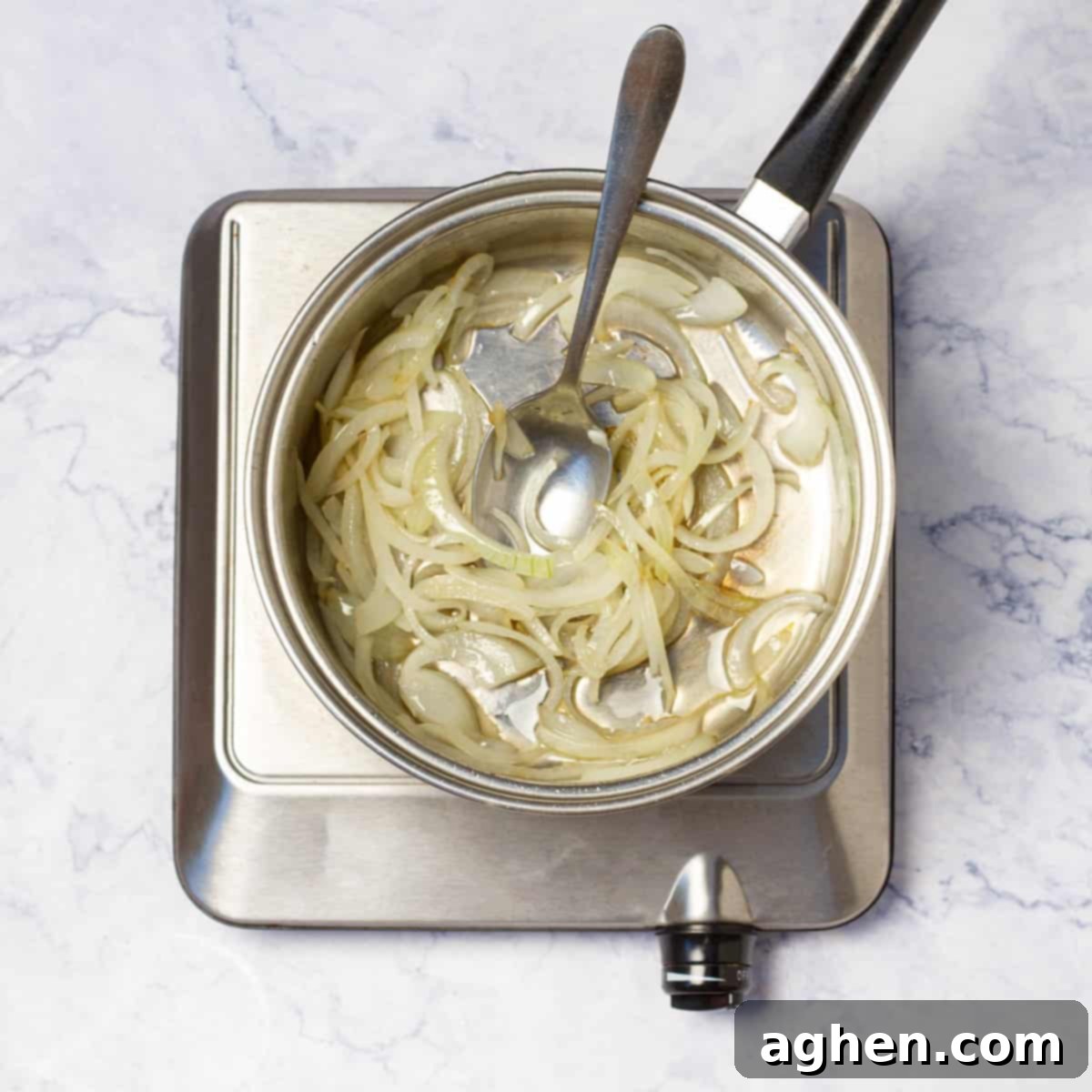
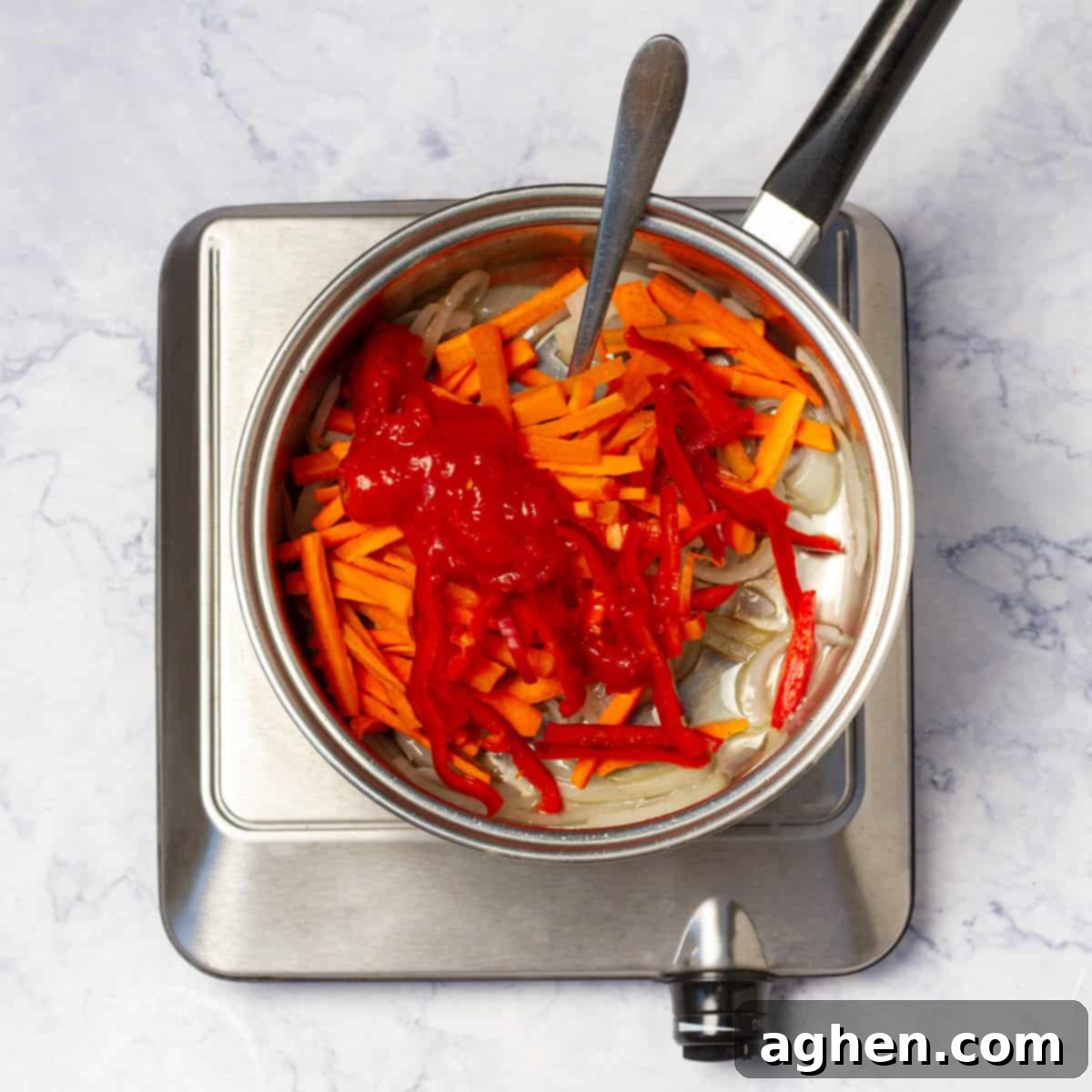
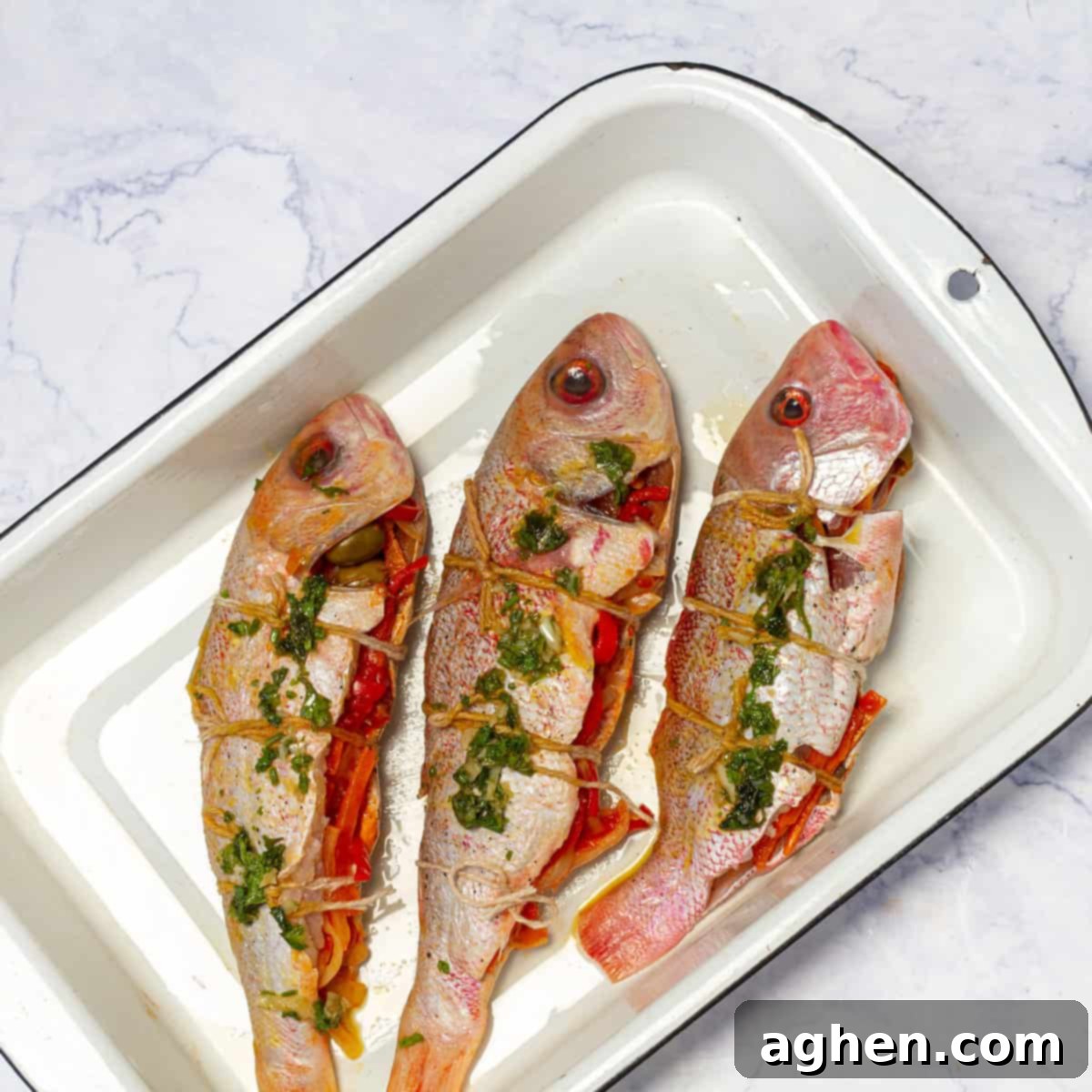
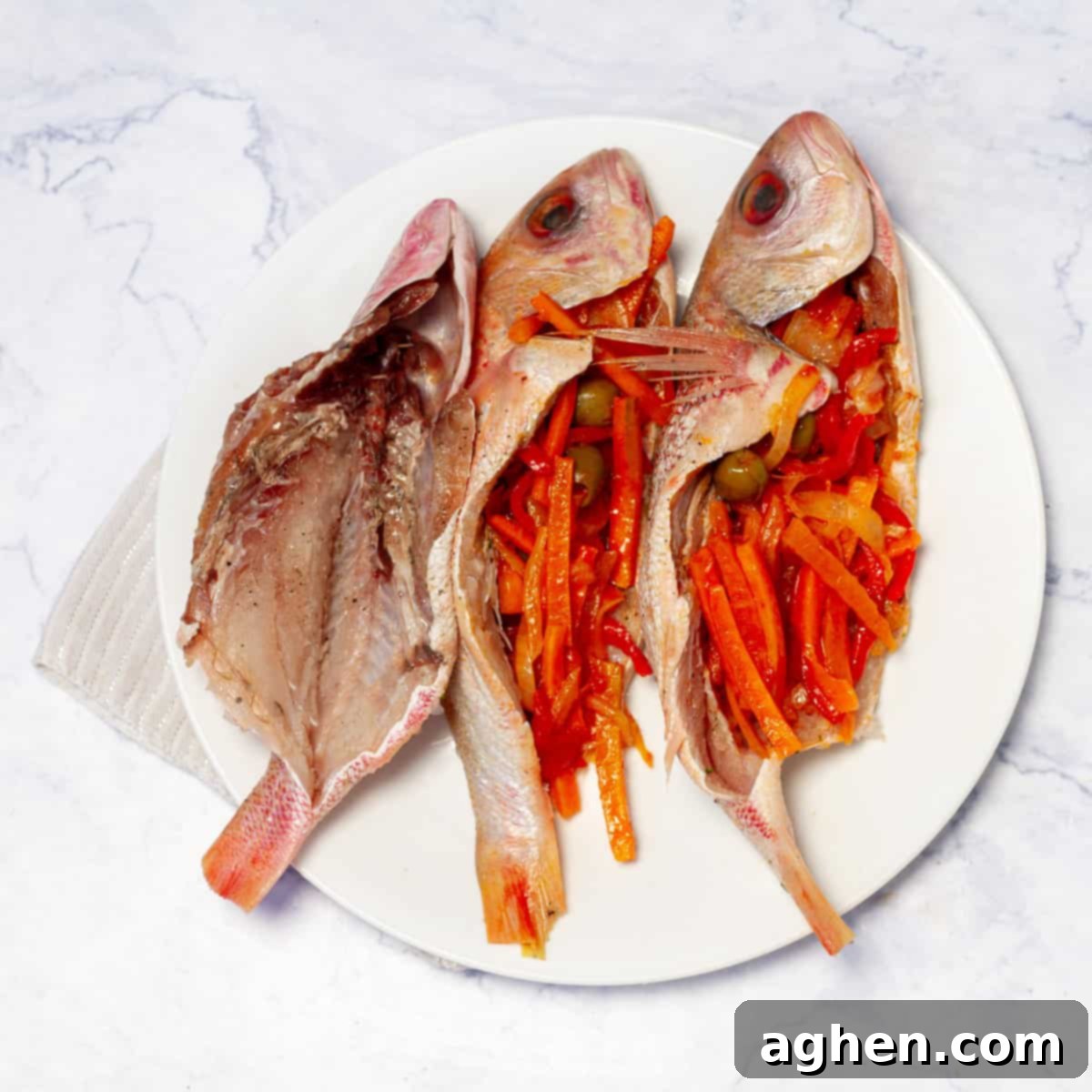
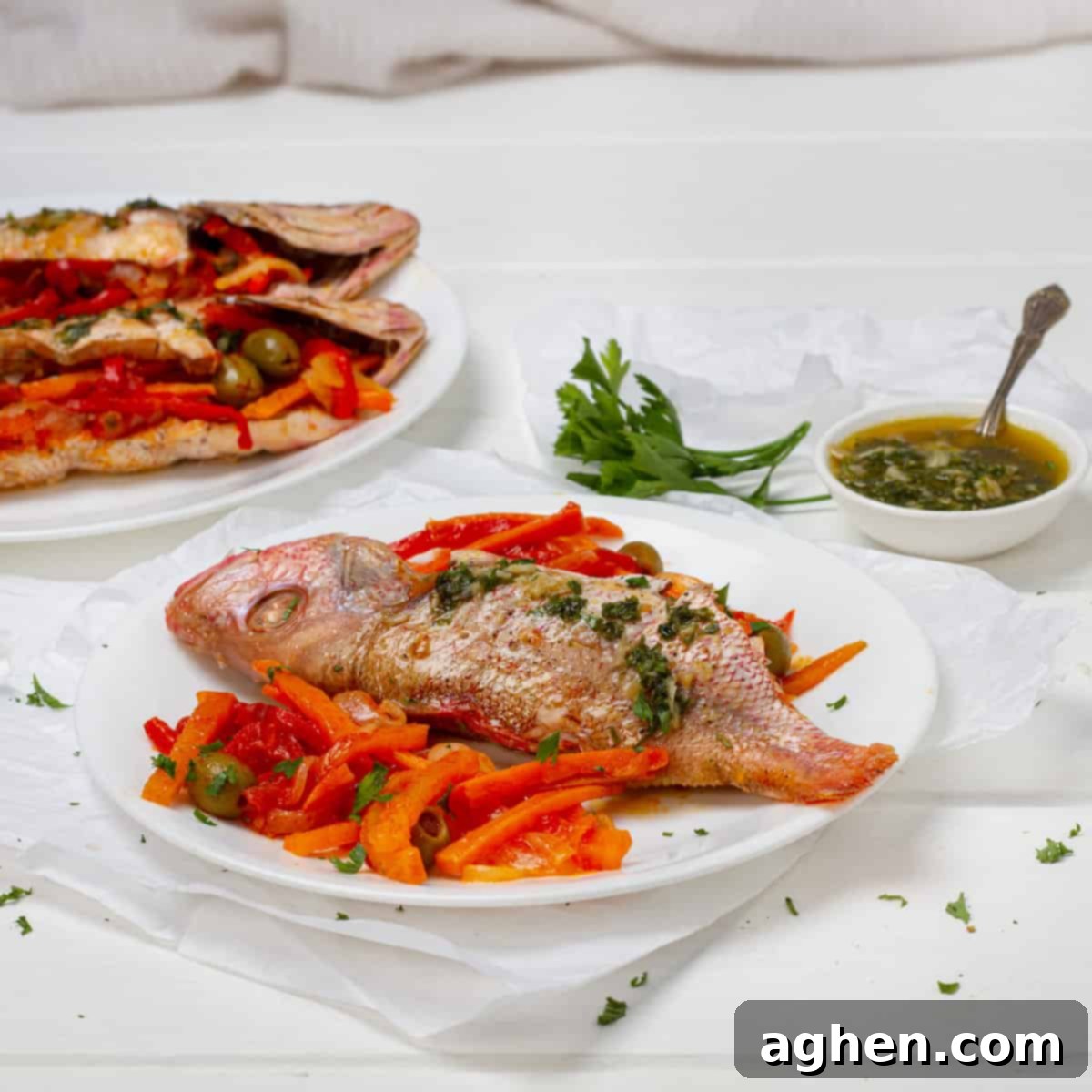
Creative Variations and Smart Substitutions for Stuffed Fish
The beauty of stuffed fish lies in its incredible versatility. Don’t be afraid to get creative and tailor this recipe to your preferences, what ingredients are available, or what’s in season. This recipe serves as an excellent foundation for endless culinary exploration:
- Beyond the Classic Fish Choices: While snapper, sea bass, and trout are fantastic choices for this recipe, many other fish varieties work beautifully for stuffing, offering different textures and flavors:
- Thicker Fillets: Salmon, cod, or halibut fillets can be butterflied or cut to create a pocket for stuffing. You can also lay the stuffing on one fillet and top with another, or roll the fillet around the stuffing and secure it with kitchen twine.
- Smaller Fish: Mackerel or sardines, once scaled and gutted, can be stuffed with a simpler mixture of herbs, breadcrumbs, and lemon for delightful individual servings or appetizers.
- Other Whole Fish: Consider red mullet, branzino, or even a larger tilapia for similar preparation methods.
- Endless Filling Possibilities: The vegetable stuffing in this recipe is just a starting point. Feel free to enhance it with these flavorful additions to truly personalize your dish:
- Cheesy Goodness: For a touch of creaminess and tang, add crumbled feta cheese, creamy goat cheese, or a spoonful of ricotta or cottage cheese to the vegetable mixture.
- Mediterranean Flavors: Incorporate sun-dried tomatoes (chopped), briny capers, finely chopped artichoke hearts, or a sprinkle of dried oregano or basil for an even more pronounced Mediterranean twist.
- Herbal Infusion: Experiment with different fresh herbs such as dill, cilantro, mint, tarragon, or chives to significantly alter and elevate the flavor profile of your stuffing.
- Grains & Nuts for Texture: Cooked quinoa, couscous, or a small amount of wild rice can add pleasant bulk and texture to the filling. Toasted pine nuts, slivered almonds, or chopped walnuts can provide a delightful crunch.
- Spicy Kick: If you enjoy a bit of heat, a pinch of red pepper flakes, finely diced jalapeño, or a dash of your favorite hot sauce can add a welcome warmth to the filling.
- Lemon & Herb Zest: For a super fresh and light filling that highlights the fish’s natural flavors, consider simply stuffing the fish with thin lemon slices, plenty of minced garlic, and a generous amount of fresh parsley or dill. This minimalistic approach is surprisingly impactful.
- Alternative Cooking Methods: Explore different ways to cook your stuffed fish for varying textures and flavors, beyond traditional baking:
- Grilling: For a smoky depth of flavor, tightly wrap the stuffed fish in foil or place it securely in a grill basket. Grill over medium-hot coals or gas until cooked through, turning once.
- Broiling: For exceptionally crispy skin and a slightly charred finish, you can bake the fish as instructed, then finish it under a preheated broiler for a few minutes. Watch carefully to prevent burning!
- Steaming: As a very healthy and light option, steaming keeps the fish incredibly moist and tender. Ensure the fish is well-sealed in parchment paper or foil to keep the filling intact while steaming.
- Pan-Searing then Baking: For extra crispy skin from the start, pan-sear the fish for 2-3 minutes per side in an oven-safe skillet before transferring it to the oven to finish baking. This adds a beautiful golden-brown crust.
Expert Tips and Tricks for Stuffed Fish Success
Achieving a perfectly cooked and flavorful stuffed fish is easy with a few simple guidelines and culinary secrets. Keep these tips in mind to ensure a truly memorable and delicious dish every time:
- Thorough Fish Preparation: The Foundation of Flavor
- Cleanliness is Paramount: Always start with meticulously cleaned fish. Ensure all scales and entrails are completely removed, as any remnants can impart an off-flavor. Rinse the fish thoroughly under cold running water, both inside and out. Patting the fish completely dry with paper towels is crucial; moisture on the skin prevents crisping and can lead to a less appealing texture and a stronger “fishy” aroma.
- Creating the Perfect Cavity: For whole fish, a deep, lengthwise incision along the belly, extending from just behind the head to the tail (but making sure not to cut through to the other side), creates the ideal pocket for your filling. If you’re unsure or prefer convenience, don’t hesitate to ask your fishmonger to prepare the fish for stuffing.
- Season Generously Inside: Do not just season the exterior! Generously rub the inside cavity of the fish with salt, freshly ground black pepper, minced garlic, and any other desired herbs. This ensures the flavor penetrates deep into the flesh, moistening and seasoning the fish from the inside out, leading to a much more flavorful final product.
- Stuffing with Precision: Preventing Spills and Ensuring Even Cooking
- Avoid Overstuffing: While it’s tempting to pack in as much delicious filling as possible, overstuffing can cause the fish to tear or burst during cooking. This not only leads to a messy presentation but can also cause the fish to dry out. Aim for a moderate amount that comfortably fills the cavity, allowing for even heat distribution.
- Secure the Filling: This is a vital step for both aesthetics and retaining flavor. Use sturdy wooden toothpicks, metal skewers, or kitchen twine to securely sew or tie the belly opening of the fish shut. This simple precaution prevents the flavorful stuffing from spilling out and drying during the baking process, keeping your dish intact and appealing.
- Optimal Baking for Best Results: Achieving Moistness and Flavor
- Foil for Moisture & Cleanup: Lining your baking sheet with aluminum foil makes cleanup a breeze and prevents the fish from sticking. Covering the fish tightly with foil for the initial part of the baking time traps steam, ensuring an incredibly moist and tender result. This also helps the fish cook evenly without drying out.
- Accurate Doneness Check: Fish cooks quickly and can easily become dry if overcooked. To check for perfect doneness, gently insert a fork into the thickest part of the fish. It should flake easily with minimal resistance and appear opaque throughout. An internal temperature of 145°F (63°C) is generally ideal for most fish varieties.
- Achieving Crispy Skin: If you desire a golden, crispy skin, remove the aluminum foil cover for the last 10-15 minutes of baking. You can also briefly broil the fish for 1-2 minutes at the very end, but watch it constantly to prevent burning, as broiler heat is intense.
- Enhancing Flavor & Presentation: The Finishing Touches
- Resting Time: Like meat, fish benefits from a brief resting period (5-10 minutes) after it comes out of the oven. This allows the juices to redistribute throughout the flesh, resulting in a more tender, flavorful, and succulent dish.
- Fresh Garnishes: A final sprinkle of fresh herbs like parsley, dill, or chives, a wedge of fresh lemon, or a drizzle of good quality extra virgin olive oil just before serving can dramatically brighten the flavors, add a fresh aroma, and provide a professional, appealing touch to your presentation.
Perfect Pairings: What to Serve with Stuffed Fish
Stuffed fish is a versatile main course that pairs wonderfully with a variety of side dishes, allowing you to create a complete, balanced, and satisfying meal. For a light and healthy accompaniment, consider serving it with a crisp green salad tossed with a simple vinaigrette, steamed asparagus spears, roasted broccoli florets, or sautéed green beans with almonds. If you prefer something heartier, a side of fluffy quinoa, fragrant couscous, a light rice pilaf, or even creamy polenta would be excellent complements, absorbing the delicious juices and sauce. The rich flavors of the fish and its savory stuffing also marry beautifully with roasted root vegetables like potatoes and carrots, or a vibrant medley of seasonal roasted vegetables. Don’t forget a slice of crusty artisan bread or warm pita to soak up any leftover aromatic butter sauce!
Storing and Reheating Stuffed Fish
Should you have any delicious leftovers from your stuffed fish meal, proper storage and reheating techniques are key to maintaining its quality. Store cooked stuffed fish in an airtight container in the refrigerator for up to 2-3 days. To maintain its moisture and flavor when reheating, it’s best to do so gently to prevent the fish from drying out. A good method is to place the fish in an oven-safe dish, cover it loosely with aluminum foil, and warm it in a preheated oven at a low temperature, around 275°F (135°C), until it is heated through. Alternatively, individual portions can be reheated in the microwave on a lower power setting, though this method may slightly alter the texture of the fish and its crispness.
Troubleshooting Common Stuffed Fish Issues
Even experienced cooks can encounter minor hiccups in the kitchen. Here’s how to address and prevent some common challenges when preparing stuffed fish, ensuring your dish turns out perfectly every time:
- Dry Fish: The most frequent cause of dry fish is overcooking. To prevent this, always monitor your cooking time closely and use a meat thermometer to ensure the fish reaches an internal temperature of 145°F (63°C) without exceeding it. Covering the fish with aluminum foil during the initial baking is also crucial for trapping moisture and keeping the fish succulent.
- Filling Spilling Out: This usually happens if the fish cavity is overstuffed or if the opening isn’t properly secured. Ensure you fill the fish comfortably, leaving a little room for expansion, and use sturdy toothpicks or kitchen twine to securely close the belly slit before baking.
- Bland Flavor: If your fish tastes a little flat, it likely needs more seasoning. Be generous with salt, pepper, and garlic both inside and outside the fish. Always taste your vegetable filling before stuffing to adjust seasonings as needed. A final squeeze of fresh lemon juice before serving can also dramatically brighten the overall flavor profile.
- Skin Not Crispy: If you prefer a beautifully golden and crispy skin, ensure the fish is patted thoroughly dry with paper towels before seasoning and baking. For the last 10-15 minutes of baking, remove the aluminum foil cover. You can also briefly broil the fish for 1-2 minutes at the very end, but watch it constantly and closely to prevent burning, as broiler heat is intense and fast-acting.
Nutrition Information & WW Points Breakdown
This stuffed fish recipe offers a healthy and satisfying meal that can easily fit into various dietary plans. Here’s an approximation of the nutritional values per serving and the Weight Watchers (WW) points for individual ingredients, providing insight into the dish’s healthful components:
Nutrition information is automatically calculated and should only be used as an approximation. Values are per serving (approximately 353g):
- Calories: 305 kcal
- Carbohydrates: 8g
- Protein: 53g
- Total Fat: 6.3g
- Saturated Fat: 1.1g
- Cholesterol: 92mg
- Sodium: 619mg
- Potassium: 1241mg
- Dietary Fiber: 2.1g
- Sugars: 2.5g
- Calcium: 89mg
- Iron: 1.3mg
WW Points per Ingredient (approximation):
- Uncooked Snapper (or similar lean fish): 0 points
- Garlic: 0 points
- Table Salt: 0 points
- Black Pepper: 0 points
- Olive Oil (1 tsp): 1 point
- Red Bell Pepper: 0 points
- Carrots: 0 points
- Tomato: 0 points
- Olives (12 pitted and sliced): 2 points
- Fresh Parsley: 0 points
- Onion: 0 points
- Light Butter (1 tbsp): 4 points
Note: The total WW points for the entire dish will depend on specific brands, exact measurements, and portion sizes. This recipe, when followed as directed and using specified ingredients, is designed to be a healthy and satisfying option, often resulting in a low total WW point count per serving. Based on these ingredient points, expect approximately 1 WW Point per serving for the final dish.
By following these simple tips and embracing the versatility of stuffed fish, you can create a memorable dining experience that’s as enjoyable to prepare as it is to savor. This delightful dish is perfect for impressing guests or simply enjoying a healthy, flavorful meal at home. Happy cooking!
